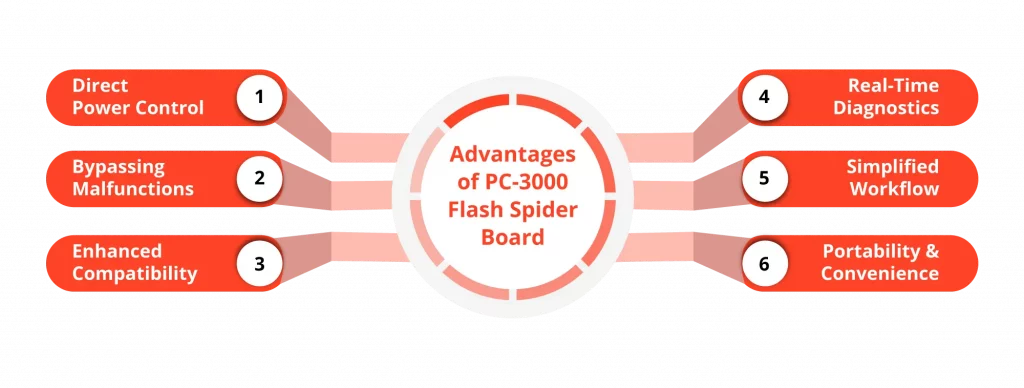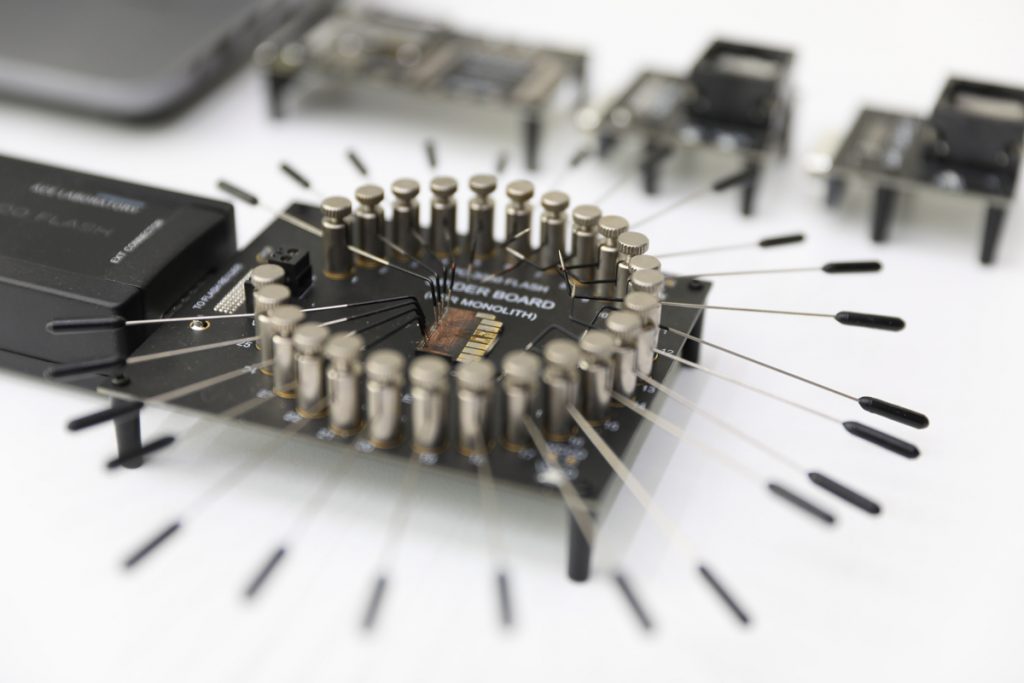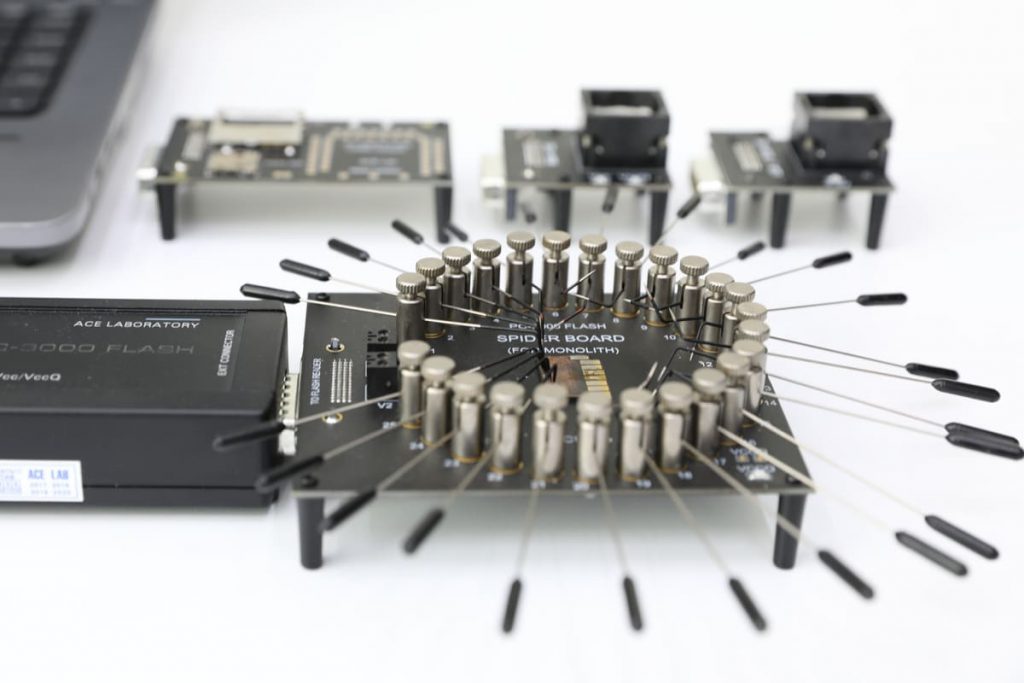Monolithic memory cards and flash drives differ from ordinary memory storage devices in that they are made in the form of a single monolithic element, i.e., we cannot allocate a memory chip and a controller. USB flash drives and SD memory cards may or may not be monolithic, but all MicroSD flash drives are.
The flash drive looks like a single piece of plastic. Monolithic flash drives use frameless elements such as controllers and memory chips, which are filled with a compound. The main problem is that if the memory chip does not have a case, then it cannot be unsoldered and read on a particular hardware reader.
The standard data recovery technique is not suitable for monolithic flash drives. To connect to a memory chip on monolithic flash drives, data recovery specialists need to strip the printed circuit board of the flash drive and connect to the necessary contacts using a special PC3000 Spider Board device.
PC-3000 Flash Spider Board
The PC-3000 Spider Board is designed to perform switching with technological outputs of drives in monolithic memory cards.
The Advantages of Using A Spider Board Include:
- Minimum Time For Inserting A Memory Card
- Ability To Connect A Logic Analyzer
- Simplicity The Process Of Researching Monoliths
Data can be recovered with the Spider Board from a variety of damaged memory cards, including Monolithic USB Flash Drive, MicroSD, SD, and others. The PC-3000 Flash Spider Board Adapter is an all-purpose way to safely restore monolithic data without tedious soldering. Our data recovery experts can use it without needing specialized adapters for each monolith you see.

It is intended to be connected to the internal contacts of single-package NAND flash memory storage devices and monolithic drives. The adapter has 25 universal connections that can be associated with NAND interface signals in a given task via software configuration.
"*" indicates required fields
How Is The Monolithic Recovery Process Performed?
Data recovery engineers at our company begin the process with a memory dump. The ROM of the device under investigation is read using the PC3000-Flash software and hardware complex, which uses the technology of direct access to NAND chips. Its connection is carried out through the PC3000 Spider Board adapter, which allows connection to the process pins of the NAND Flash chip without soldering due to 25 movable needle contacts.
In the process of long-term storage of NAND Flash chips without maintaining the supply voltage, the likelihood of charges flowing between memory cells increases. It also rises due to the dismantling of the shielded ROM since, in order to remove the protective shield from EMP, our engineers have to heat it with a soldering station.
The flow of charges leads to the appearance of bit errors, the frequency of which depends mainly on the type of flash memory and the features of its technical design.
Dump Analysis With PC-3000 Package
To search for partition offsets, types of file systems, and to determine the presence of encryption or compression, the data extractor program from the PC3000-Flash package is used.
Further analysis of the resulting dump is carried out using the Binwalk firmware analysis utility and self-written software tools.

The widespread archiver 7-Zip is also used, as it is able to extract data from various file systems and compiled libraries. With it, there is no need to look for specialized unpackers for each format, which significantly saves our clients’ and engineers’ time.
When our technicians finish subtracting the dumps, they perform the necessary transformations with the dumps.
Those modifications include eliminating bit errors, characteristic interleaves, and others. The last step is to build a virtual translator according to the scheme and recover all the essential files.
By having a vast range of donor drives, cutting-edge tools, state-of-the-art laboratories, and highly skilled engineers, we maintain the highest 99% success rate in the industry. All the described processes are carried out in an ISO Certified Class 10 Cleanroom so that small particles would harm no flash drives and SD cards. Contact us for professional monolith data recovery services.
Frequently Asked Questions
What is the Spider Board Technique for monolithic storage data recovery?
The Spider Board Technique is an advanced data recovery method used to retrieve data from monolithic storage devices, such as monolithic flash memory chips or NAND chips. It involves intricate soldering of micro wires to specific points on the monolithic chip to access and recover data.
When is the Spider Board Technique employed for data recovery?
The Spider Board Technique is employed when traditional data recovery methods, like chip-off or chip-on methods, are not feasible due to the chip’s construction or when the data is stored on a monolithic NAND chip without removable components.
How long does the data recovery process using the Spider Board Technique typically take?
The time required for recovery varies depending on factors such as the size of the storage device, the extent of data loss, and the complexity of the case. In most instances, the Spider Board Technique can yield results within a few days to a couple of weeks.
Is it possible to attempt the Spider Board Technique for monolithic storage data recovery as a DIY project?
Attempting the Spider Board Technique as a DIY project is highly discouraged. It requires specialized equipment, extensive expertise, and a controlled environment. DIY attempts can damage the storage device and result in permanent data loss.
